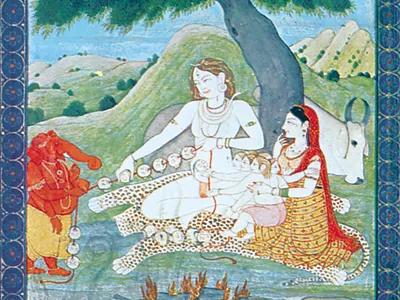SHIVA Shiva, the sage, remains absorbed within himself, but he is full of wrath and ire. (Wadhans M. 3, p. 559) Shiva, the Yogi, though tired of smearing his body, could not know Thy end, O Lord! (Suhi M. 5, p. 747) Shiva does not know the secret of the Lord. (Ramkali M. 5, p. 894) O Pundit! I saw your Mahadeva (Shiva) coming; while riding on his white Bull, his meal was prepared in the house of the storekeeper, which he did not like and in rage,killed his son.
(Gond Namdev, p. 875) Those who meditate on the name of Shiva, they ride on the Bull and beat the tabor. (Gond Namdev, p. 874) The heaven of Shiva will come to an end. (Gauri M. 5, p. 237) Though the moon abides on the forehead of Shiva and bathes in the Ganges and in his own elan, he came into contact with Kristina, the incarnation of Vishnu, but the blemish from his face in not dispelled because of his past deed (the blemish of helping Indra to seduce Ahalya).
(Dhanasari Trilochan, p. 695) The Lord Willed that Shiva be defeated by Shakti. (Var Maru Dakhne M. 5, p. 1096) One of the gods of Hindu Triad, who represents the quality of Tamasa. Though he is a Yogi and very wise, he is full of wrath and ire. The Supreme Being has assigned him the task of destruction. The word Shiva is often used for the Supreme Being like Vishnu, but as the god of Triad, he is considered a disciple of Maya. His consort Parbati (also called Durga, Bhavani, Sati, Uma, Chandi etc.) is also called Shakti.
Figuratively, this world is called a play of Shiva and Shakti. Shakti is maya. The Vehicle of Shiva is the Bull Nandi. Though there is mention of the heaven of Shiva, he is generally shown as a wandering mendicant, mostly haunting the cremation grounds and accompanied by ghosts, goblins and evil spirits. His matted locks are tied in the coils of a serpent, which holds its hood raised over his head. He carries a tabor in his hand and is fabled to have received the Ganges in his locks. When the milk ocean was churned, he drank the poison that appeared on the surface of the ocean.
The poison got stuck up in his throat, which gave a dark blue colour to his throat. This is the reason why he is called ‘Neelkantha’. He has a third eye in his forehead and carries a trident in his second hand. He is also said to have some incarnations. There is a crescent or half-moon on his forehead. See : Chaudaha Ratan Ganges and Bull
References :
1. Kohli,Surindar Singh ed,Dictionary of Mythological References in Guru Granth Sahib 1993
Shiva, one of the principal deities in Hindu mythology, is a complex and multifaceted figure revered as the Destroyer within the Trimurti (the Hindu trinity of Brahma, Vishnu, and Shiva). His role transcends destruction, encompassing creation, transformation, and preservation, making him a central figure in Hindu spirituality and philosophy.
Key Aspects of Shiva:
Names and Epithets:
- Shiva is known by numerous names, each reflecting a different aspect of his divine nature, such as Mahadeva (Great God), Shankara (Beneficent), Rudra (Fierce), and Nataraja (Lord of Dance).
- He is also called Adiyogi, the first yogi, symbolizing his role as the originator of yoga and meditation.
Iconography:
- Shiva is depicted with distinctive attributes:
- Third Eye: Represents higher consciousness and the ability to destroy ignorance.
- Trishula (Trident): Symbolizes the three fundamental aspects of existence—creation, preservation, and destruction.
- Damaru (Drum): Represents the cosmic sound and rhythm of creation.
- Crescent Moon: Signifies the passage of time and the cycles of nature.
- River Ganga: Flowing from his matted hair, it symbolizes purification and life-giving energy.
- Serpent Vasuki: Around his neck, it represents control over primal forces.
Abode and Family:
- Shiva resides on Mount Kailasa, a symbol of spiritual ascension and detachment.
- His consort is Parvati, the goddess of power and fertility, and his children include Ganesha (remover of obstacles) and Kartikeya (god of war).
Cosmic Role:
- As the Destroyer, Shiva dismantles the universe at the end of each cosmic cycle, paving the way for renewal and creation.
- He is also the Lord of Dance, performing the Tandava, a cosmic dance that symbolizes the cycles of creation, preservation, and destruction.
Worship and Practices:
- Shiva is worshipped in both anthropomorphic forms and as the Shiva Lingam, an abstract representation of his divine energy.
- Devotees observe rituals like Maha Shivaratri, a festival dedicated to his worship, and chant mantras such as Om Namah Shivaya to seek his blessings.
Symbolism:
- Shiva embodies the duality of existence—benevolence and fierceness, asceticism and family life, destruction and creation.
- He represents the ultimate reality (Brahman) and the path to liberation (moksha).
Shiva’s mythology and significance are vast, encompassing stories of his interactions with gods, demons, and devotees.



